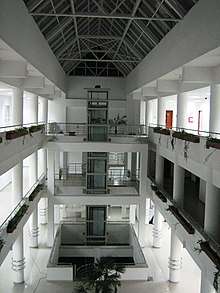Ștefan cel Mare University of Suceava
The Ștefan cel Mare University of Suceava (Romanian: Universitatea „Ștefan cel Mare” din Suceava), also known as University of Suceava, is a public university in Suceava, Romania, founded in 1990. It was named in honor of the Moldavian Prince Stephen the Great.
Universitatea „Ștefan cel Mare” din Suceava | |
 | |
| Type | Public |
|---|---|
| Established | 7 March, 1990 |
| Rector | Valentin Popa |
| Students | 8,222 (2015–2016)[1] |
| Location | , |
| Website | www.usv.ro |
History

The first higher education school in Suceava was founded in 1963 as the Institute of Pedagogy. The institution had three faculties: Letters, Mathematics and Physics, and History and Geography. In 1984, it was transformed into the Sub-Engineering Institute, subordinated to the Technical University of Iași.
In 1990, after officially given the university title by the Romanian government, the institution started to individualize throughout academic consolidation, didactic and scientific diversification, not least by getting better known nationally and internationally. In September 2008, the university was awarded with a High Confidence Rating by the executive bureau of ARACIS (Romanian Agency for Quality Assurance in Higher Education). In 2009, the Ștefan cel Mare University was ranked fourth on a list created by the Kienbaum Management Consultants firm in cooperation with Capital financial magazine about the images universities have among employers.[2]
Timeline
- 1963–1975: Higher educational phase - Institute of Pedagogy
- 1976–1984: Joint Institute for Higher Education, Pedagogical and Technical
- 1984–1989: Institute of Associate Engineering (part of the Gheorghe Asachi Polytechnic Institute of Iași)
- 1985: Power Engineering was introduced to train engineers (6 years of studies and evening courses only).
- 1986: Evening courses in Automation and Computers were held for the first time (6 years of studies).
- Post–1990: "Ștefan cel Mare" University of Suceava
- 1990: Day courses on a 5-year basis were first introduced for both specializations; Automation and Electromechanics specializations were established, Engineer degree, day courses (5 years) and evening courses (6 years); the Electrotechnics Chair was established, which represented the forerunner of the Faculty of Electrical Engineering.
- 1991: The Faculty of Electrical Engineering was established; the Computers and Automation Chair was established; the Engineer Diploma was awarded to the first generation of graduates in Power Engineering.[3]
Faculties

Nowadays, the Ștefan cel Mare University has 10 faculties:
- Faculty of Economics and Public Administration
- Faculty of Educational Sciences
- Faculty of Electrical Engineering and Computer Science
- Faculty of Food Engineering
- Faculty of Forestry
- Faculty of History and Geography
- Faculty of Law and Administrative Sciences
- Faculty of Letters and Communication Sciences
- Faculty of Mechanical Engineering, Mechatronics and Management
- Faculty of Physical Education and Sports
International relations
In 2018–19, USV reported international agreements with universities in Algeria, Armenia, Azerbaijan, Bulgaria, Cameroon, China, Côte d’Ivoire, Croatia, Czech Republic, Ecuador, France, Germany, Georgia, Hungary, Greece, Jordan, Indonesia, Israel, Italy, Japan, Kazakhstan, Kyrgyzstan, Morocco, Moldova, Poland, Portugal, Russia, Senegal, Slovakia, South Korea, Spain, Sweden, Switzerland, Togo, Turkey, Ukraine, and United Kingdom.[4] It is also a partner of the EUROSCI Network.[5]
References
- Raport privind starea universităţii, 2015
- Topul universităţilor din România, September 2009
- "USV, Faculty of Electrical Engineering and Computer Science - Timeline History".
- "International Agreements". Office for European Affairs. Universitatea "Stefan cel Mare" din Suceava. Retrieved 2 March 2019.
- "Ştefan cel Mare University of Suceava". Times Higher EducationWorld University Rankings. Retrieved 18 December 2019.
External links
| Wikimedia Commons has media related to Ștefan cel Mare University of Suceava. |
